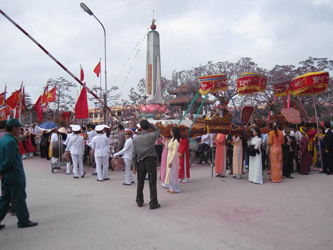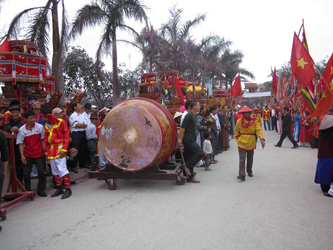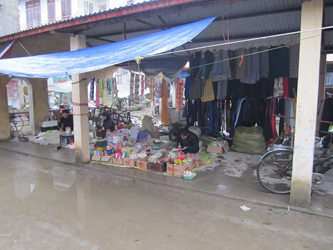Fieldwork in Vietnam
My PhD project traces the experiences of marketisation in late-socialist Vietnam, grounded in a North Vietnamese village where market transformations have been and are being manifested in unpredictable and changing ways. Its main focus is the diverse and complex trajectories in which rural economic life is being lived against the backdrop of many unpredictabilities that emerge as the country is changing towards a market economy. The images below illustrate my most profound impressions so far of present-day Vietnam as a country where everyday manifestations of late-socialist transformations, both economic and non-economic, are defying easy attempts to categorise social changes into clear-cut models and to place them into a unilinear line of transition. The snapshots of life captured here display an astonishing degree of harmony between cultural markers associated with ideologies ostensibly contradictory and uncoexistable. They calls into question the view of presocialist traditions as being revived and making a come-back in face of the collapse of socialism, as well as teleological assumptions that sponsor the withering away of socialist potency in the context of market reforms. They also challenge views of late-socialist change as featuring either an uncritical embracement of Western modernity or an outright rejection of it, as once observed in other post-socialist contexts. For an ethnographer, those pictures strongly invite anthropological efforts to discover and make sense of the complexities and subtleties currently driving the many unpredictable and creative paths on which late-socialist marketisation in Vietnam is being played out.
 A village parade marching towards the local War Martyr Monument, an architecture specifically designed to embody and uphold socialist characteristics and ideals, in preparation for the opening of the traditional village festival. The annual celebration of the event has been resumed in the last two decades after a long period of suppression as the consequence of socialist campaigns of cultural and ideological reforms since the late 1950s. The monument, of distinctive socialist style with a central concrete tower topped by a star, is creatively placed on top of a pink lotus-shaped pedestal, both a symbol of the nation and of Buddhism. Once banned from publicly practiced together with many other non-socialist forms of public celebration, Buddhism is in recent years revitalised, as in the case of other religious practices, and increasingly re-incorporated in both folk and officially-sanctioned festivities. The monument stands before the new stele house easily recognisable as of traditional architectural style with distinctive curve-shaped roof decorated with dragon engravings. Placed inside the house are marble stelae engraved with the names of villagers who served and died in the two revolutionary wars against the French and the American in the 20th century. The co-existence of multiple ideologies is further manifested in the attires of heterogeneous styles worn by paraders. Leading the parade are women mostly of very young ages wearing Soviet-style kepi caps and white uniforms, while carrying national music instruments such as the cylindrical drums or trống cơm. In the middle, the ancient-style, lacquered and gilded palanquin of the village tutelary god is carried by four middle-aged women wearing long dress or ao dai. Though the festival is often referred to in media, by state agencies and villagers themselves as “traditional,” the presence of those women is in sharp contrast to pre-socialist moralities, particularly to Confucian norms that absolutely forbade women from participating in and having direct contact with ritual events, spaces and objects. The present-day popularity of ao dai is also of socialist orign, as it was during the heyday of socialism in Vietnam that the attire was promoted by revolutionary leaders as a cultural markers of socialist modernity. It also worth noting that ao dai today continues to be widely promoted by state-sponsored media, particularly on propaganda pictures and posters, as the standard dress code of female Vietnamese moderns capable of both preserving the national culture and succeeding in the global market economy.
A village parade marching towards the local War Martyr Monument, an architecture specifically designed to embody and uphold socialist characteristics and ideals, in preparation for the opening of the traditional village festival. The annual celebration of the event has been resumed in the last two decades after a long period of suppression as the consequence of socialist campaigns of cultural and ideological reforms since the late 1950s. The monument, of distinctive socialist style with a central concrete tower topped by a star, is creatively placed on top of a pink lotus-shaped pedestal, both a symbol of the nation and of Buddhism. Once banned from publicly practiced together with many other non-socialist forms of public celebration, Buddhism is in recent years revitalised, as in the case of other religious practices, and increasingly re-incorporated in both folk and officially-sanctioned festivities. The monument stands before the new stele house easily recognisable as of traditional architectural style with distinctive curve-shaped roof decorated with dragon engravings. Placed inside the house are marble stelae engraved with the names of villagers who served and died in the two revolutionary wars against the French and the American in the 20th century. The co-existence of multiple ideologies is further manifested in the attires of heterogeneous styles worn by paraders. Leading the parade are women mostly of very young ages wearing Soviet-style kepi caps and white uniforms, while carrying national music instruments such as the cylindrical drums or trống cơm. In the middle, the ancient-style, lacquered and gilded palanquin of the village tutelary god is carried by four middle-aged women wearing long dress or ao dai. Though the festival is often referred to in media, by state agencies and villagers themselves as “traditional,” the presence of those women is in sharp contrast to pre-socialist moralities, particularly to Confucian norms that absolutely forbade women from participating in and having direct contact with ritual events, spaces and objects. The present-day popularity of ao dai is also of socialist orign, as it was during the heyday of socialism in Vietnam that the attire was promoted by revolutionary leaders as a cultural markers of socialist modernity. It also worth noting that ao dai today continues to be widely promoted by state-sponsored media, particularly on propaganda pictures and posters, as the standard dress code of female Vietnamese moderns capable of both preserving the national culture and succeeding in the global market economy.
 The parade in waiting before the official opening ceremony of the festival. Before the festival begins, incense must first be offered to the war martyrs worshipped at the Monument. In the middle stand people representative of different social, religious and political institutions who will make offering on behalf of the whole village: the Buddhist Venerable chairing the local Buddhist church in the brown Buddhist’ robe, the commune’s Chairman of the People’s Committe and the local Secretary of the Communist Party in Western-style suits, and village elders inapparently traditional male attires with turban and tunic. They are standing in front of the palanquins carrying the name tablets of tutelary gods, except for the one in the middle that carries a bust of Vietnam communist and revolutionary leader Ho Chi Minh. The festive atmosphere is further coloured with a jungle of flags, including the distinctively national flags with a bright star on a red background, flying shoulder to shoulder with the five-coloured flags, the symbolic markers of folk culture, rituals and festivities once banned from public display by the socialist state from the late 1950s until the early 1980s.
The parade in waiting before the official opening ceremony of the festival. Before the festival begins, incense must first be offered to the war martyrs worshipped at the Monument. In the middle stand people representative of different social, religious and political institutions who will make offering on behalf of the whole village: the Buddhist Venerable chairing the local Buddhist church in the brown Buddhist’ robe, the commune’s Chairman of the People’s Committe and the local Secretary of the Communist Party in Western-style suits, and village elders inapparently traditional male attires with turban and tunic. They are standing in front of the palanquins carrying the name tablets of tutelary gods, except for the one in the middle that carries a bust of Vietnam communist and revolutionary leader Ho Chi Minh. The festive atmosphere is further coloured with a jungle of flags, including the distinctively national flags with a bright star on a red background, flying shoulder to shoulder with the five-coloured flags, the symbolic markers of folk culture, rituals and festivities once banned from public display by the socialist state from the late 1950s until the early 1980s.
 A corner of the village market. The village where I live is pervaded with general provision shops of this kind. Such a shop offers commodities that can satisfy multiple kinds of demands and that, in an urban context, have to be obtained from several separate stalls. It at the same time displays consumer items that carry the symbols of different temporalities, signaling both spiritual piety and an embracement of modern consumerism. On a small platform of less than 10 square metres, this lady is displaying (1) food, spices and cooking ingredients (two baskets of free-range eggs, a box of grains of different colours and kinds, a few bunches of dry rice noodle, a box of cooking oil, fish sauce, vinegar and chilli sauce); (2) daily necessities that bare modern trademarks of Western origins (OMO detergents – the equivalent brand of SURF in Vietnam, COLGATE toothpaste in the left corner, and plastic daily packs of CLEAR shampoo on the line hung across the front of the shop), (3) ritual items (two quires of votive paper and a few bunches of incense can be seen in the left corner as well) and (4) clothes (all are of modern, Westernised styles, some already on display and others left packed in the large bag in the right). All of these can be cleverly repacked in a single, artisanally produced wheeled push-cart, like the one behind the lady’s back.
A corner of the village market. The village where I live is pervaded with general provision shops of this kind. Such a shop offers commodities that can satisfy multiple kinds of demands and that, in an urban context, have to be obtained from several separate stalls. It at the same time displays consumer items that carry the symbols of different temporalities, signaling both spiritual piety and an embracement of modern consumerism. On a small platform of less than 10 square metres, this lady is displaying (1) food, spices and cooking ingredients (two baskets of free-range eggs, a box of grains of different colours and kinds, a few bunches of dry rice noodle, a box of cooking oil, fish sauce, vinegar and chilli sauce); (2) daily necessities that bare modern trademarks of Western origins (OMO detergents – the equivalent brand of SURF in Vietnam, COLGATE toothpaste in the left corner, and plastic daily packs of CLEAR shampoo on the line hung across the front of the shop), (3) ritual items (two quires of votive paper and a few bunches of incense can be seen in the left corner as well) and (4) clothes (all are of modern, Westernised styles, some already on display and others left packed in the large bag in the right). All of these can be cleverly repacked in a single, artisanally produced wheeled push-cart, like the one behind the lady’s back.
